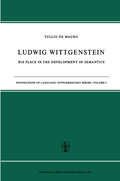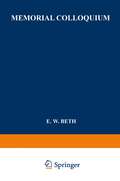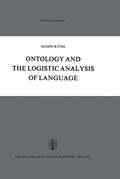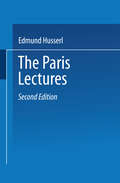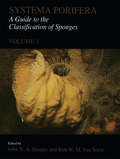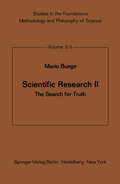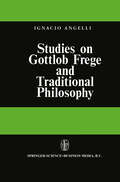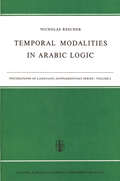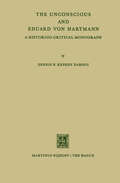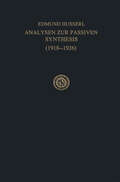- Table View
- List View
Grundzüge der theoretischen Logik (Grundlehren der mathematischen Wissenschaften #27)
by David Hilbert Wilhelm AckermannDie theoretische Logik, auch mathematische oder symbolische Logik genannt, ist eine Ausdehnung der formalen Methode der Mathematik auf das Gebiet der Logik. Sie wendet für die Logik eine ähnliche Formel sprache an, wie sie zum Ausdruck mathematischer Beziehungen schon seit langem gebräuchlich ist. In der Mathematik würde es heute als eine Utopie gelten, wollte man beim Aufbau einer mathematischen Disziplin sich nur der gewöhnlichen Sprache bedienen. Die großen Fortschritte, die in der Mathematik seit der Antike gemacht worden sind, sind zum wesentlichen Teil mit dadurch bedingt, daß es gelang, einen brauchbaren und leistungsfähigen Formalismus zu finden. - Was durch die Formel sprache in der Mathematik erreicht wird, das soll auch in der theoretischen Logik durch diese erzielt werden, nämlich eine exakte, wissenschaftliche Behandlung ihres Gegenstandes. Die logischen Sachverhalte, die zwischen Urteilen, Begriffen usw. bestehen, finden ihre Darstellung durch Formeln, deren Interpretation frei ist von den Unklarheiten, die beim sprachlichen Ausdruck leicht auftreten können. Der Übergang zu logischen Folgerungen, wie er durch das Schließen geschieht, wird in seine letzten Elemente zerlegt und erscheint als formale Umgestaltung der Ausgangsformeln nach gewissen Regeln, die den Rechenregeln in der Algebra analog sind; das logische Denken findet sein Abbild in einem Logikkalkül. Dieser Kalkül macht die erfolgreiche Inangriffnahme von Problemen möglich, bei denen das rein inhaltliche Denken prinzipiell versagt. Zu diesen gehört z. B.
The Logic of Invariable Concomitance in the Tattvacintāmaṇi: Gaṅgeśa’s Anumitinirūpaṇa and Vyāptivāda with Introduction Translation and Commentary
by C. GoekoopThe history of Indian logic is roughly divided into three periods: old Nyaya, Buddhist logic and new Nyaya. Each period is characterized by the production of some outstanding Sanskrit text. The main texts of the first and second period have been translated into, and explained in, European languages. But the principal text of the third period, GaIigesa's Tattvacintamal).i, is still not accessible through a Western language. The present book is intended to fill up this gap to some extent. The object of this study is to present both to sanskritists and to logicians an essential part of Indian logic as laid down in the first two sections of the Anumanakhal).c;la of the Tattvacintamal).i. No attention will be paid here to the doctrines of GaIigesa's predecessors and the theories developed by his commentators. Though this study is not con cerned with comparative philosophy, Western logic will be employed for the purpose of interpretation. Under Western logic I bring both traditional logic and modern logic, which, in my opinion, form one discipline of reasoning. This may account for my use of some Latin terms belonging to scholastic thought. Transliteration and translation have been made from the text of the Anumitiniriipal).a and Vyaptivada in the Bibliotheca Indica edition of GaIigesa's Tattvacintamal).i (with Mathuranatha's commentary), Part II Anumanakhal).c;la from Anumiti to Biidha, Calcutta, 1892. A photostatic copy ofthat text precedes the transliteration, translation and commentary.
Ludwig Wittgenstein: His Place in the Development of Semantics (Foundations of Language Supplementary Series #3)
by T. De MauroVarious students of general linguistics and semantics quote and discuss Wittgenstein, among others, OGDEN and RICHARDS (1960), ULLMANN (1951, 1962), PAGLIARO (1952, 1957), WELLS (1960), REGNELL (1960) and 1 ZIFF (1960). For the most part however they quote the Tractatus and not 2 the Philosophical Investigations ; not all of them consider the most important ideas in the Tractatus but often discuss marginal points; above all they often make the discussion of Wittgenstein's ideas secondary to the development of their own thought. It should be added, moreover, that these students are exceptions. The large majority of language theorists, especially those with a philological background, have almost no know ledge of Wittgenstein's ideas. One scholar thinks that Wittgenstein's linguistic philosophy rests upon a grotesque misunderstanding of the workings of language (HERDAN, 1962, Chapter 24). The present book seeks to draw the attention of students of general linguistics and semantics to the thought of both the early and the later Wittgenstein: not only the Philosophical Investigations but also the Tractatus is concerned with everyday language: Wittgenstein was thinking of the propositions of everyday language, when he affirmed that the proposition is a picture of reality (Chapter 1). This conception is very old, it is in fact found in Aristotle and it dominated ancient, mediaeval and modern rationalistic thought; only Locke, Vico and Leibniz criticized it strongly (Chapter 2).
Memorial Colloquium: Logic and Foundations of Science Paris, Institut Henri Poincaré, 19–21 May 1964
by Beth (E.W. ) Memorial Colloquim, Institut Henri Poincaré Evert Willem Beth Jean Louis DestouchesMoral Strategy: An Introduction to the Ethics of Confrontation
by James K. FeiblemanNo statement, except one, can be made with which all philosophers would agree. The exception is this statement itself. The disagreement has the advantage that it gets all the proposals out into the open where they can be examined, but it has the dis advantage that the cogency of any one philosophy must rely entirely upon that wide public which is unprepared to deal with it. Fortunately, ethics has a more immediate appeal than some other branches of philosophy; yet the history of the topic gives no indication that this circumstance has had the happy results we might have expected. One peculiarity of ethics is that its problems are rarely settled on its own grounds. Ethical problems are for the most part referred to socially established moralities, and moralities are socially established not on the basis of philosophy but rather by some sponsoring insti or politics. Such establishments, however, tution, usually religion depend on the prior preparation of ethical proposals by philosophers. For it stands to reason that an ethics cannot be socially established if there is no ethics to establish. Thus philosophers provide the justifi cation for socially-established moralities while seeming not to do so.
The New High Priesthood: the social, ethical and political implications of a marketing-orientated society
by Ralph GlasserOntology and the Logistic Analysis of Language: An Enquiry into the Contemporary Views on Universals (Synthese Library #13)
by Guido KüngIt is the aim of the present study to introduce the reader to the ways of thinking of those contemporary philosophers who apply the tools of symbolic logic to classical philosophical problems. Unlike the "conti nental" reader for whom this work was originally written, the English speaking reader will be more familiar with most of the philosophers dis cussed in this book, and he will in general not be tempted to dismiss them indiscriminately as "positivists" and "nominalists". But the English version of this study may help to redress the balance in another respect. In view of the present emphasis on ordinary language and the wide spread tendency to leave the mathematical logicians alone with their technicalities, it seems not without merit to revive the interest in formal ontology and the construction of formal systems. A closer look at the historical account which will be given here, may convince the reader that there are several points in the historical develop ment whose consequences have not yet been fully assessed: I mention, e. g. , the shift from the traditional three-level semantics of sense and deno tation to the contemporary two-level semantics of representation; the relation of extensional structure and intensional content in the extensional systems of Wittgenstein and Carnap; the confusing changes in labelling the different kinds of analytic and apriori true sentences; etc. Among the philosophically interesting tools of symbolic logic Lesniewski's calculus of names deserves special attention.
The Order of Minims in Seventeenth-Century France (International Archives of the History of Ideas Archives internationales d'histoire des idées #20)
by P.J.S. WhitmorePhilosophical Logic (Tulane Studies in Philosophy #16)
by Robert L. Arrington Peter M. Burkholder Shannon Dubose James W. Dye James K. Feibleman Bertrand P. Helm Max Hocutt Harold N. Lee Louise N. Roberts John C. Sallis Donald H. WeissWith this issue we initiate the policy of expanding the scope of Tulane Studies in Philosophy to include, in addition to the work of members of the department, contributions from philosophers who have earned advanced degrees from Tulane and who are now teaching in other colleges and universities. The Editor THE LOGIC OF OUR LANGUAGE ROBERT L. ARRINGTON Wittgenstein wrote in the Tractatus that "logic is not a body of doctrine, but a mirror-image of the world. " 1 In line with his suggestion that a proposition is a 'picture', Wittgenstein argued that propositions 'show' the logical structure of the real. He was insistent, however, that "the apparent logical form of a proposition need not be its real one. " 2 As a result of this we can misunderstand the structure of fact. Philosophical problems arise just when "the logic of our language is mis understood. " 3 It is common knowledge that much of this view of logic was rejected by Wittgenstein himself in the Philosophical Investi gations. There we are told that language has no ideal or sublime 4 logic which mirrors the structure of the extra-linguistic world. Consequently, inferences from the structure of language to the structure of that extra-linguistic world are invalid. Reality can be 'cut up' in any of a number of ways by language. Wittgenstein adopted a view of philosophy which would render that discipline a non-explanatory, non-critical study of the multiple ways in which language can be used.
Polish Analytical Philosophy: A Survey and a Comparison with British Analytical Philosophy (Routledge Revivals)
by Henryk SkolimowskiFirst published in 1967, Polish Analytical Philosophy presents the first comprehensive study of Polish analytical philosophy that has been written in Polish or English, traces the origin of the Polish analytical movement, it's development in the period between the World Wars, and its decline after the Second World War. The book shows that although inspired by the British movement and in close touch with the Vienna circle, Polish philosophy acquired its own distinctive character. Analytical philosophy in Poland was actively engaged in logic and language but tended rather to be interested in constructing philosophical doctrines which attempted to resolve traditional problems of ontology and epistemology.The author contrasts leading representatives of analytical philosophy in Britain and in Poland, and his study will be a valuable addition to the literature of the analytical trend in Europe.
Polish Analytical Philosophy: A Survey and a Comparison with British Analytical Philosophy (Routledge Revivals)
by Henryk SkolimowskiFirst published in 1967, Polish Analytical Philosophy presents the first comprehensive study of Polish analytical philosophy that has been written in Polish or English, traces the origin of the Polish analytical movement, it's development in the period between the World Wars, and its decline after the Second World War. The book shows that although inspired by the British movement and in close touch with the Vienna circle, Polish philosophy acquired its own distinctive character. Analytical philosophy in Poland was actively engaged in logic and language but tended rather to be interested in constructing philosophical doctrines which attempted to resolve traditional problems of ontology and epistemology.The author contrasts leading representatives of analytical philosophy in Britain and in Poland, and his study will be a valuable addition to the literature of the analytical trend in Europe.
Proceedings of the Boston Colloquium for the Philosophy of Science 1964/1966: In Memory of Norwood Russell Hanson (Boston Studies in the Philosophy and History of Science #3)
by Norwood Russell HansonThis third volume of Boston Studies in the Philosophy of Science contains papers which are based upon Colloquia from 1964 to 1966. In most cases, they have been substantially modified subsequent to presentation and discussion. Once again we publish work which goes beyond technical analysis of scientific theories and explanations in order to include philo sophical reflections upon the history of science and also upon the still problematic interactions between metaphysics and science. The philo sophical history of scientific ideas has increasingly been recognized as part of the philosophy of science, and likewise the cultural context of the genesis of such ideas. There is no school or attitude to be taken as de fining the scope or criteria of our Colloquium, and so we seek to under stand both analytic and historical aspects of science. This volume, as the previous two, constitutes a substantial part of our final report to the U. S. National Science Foundation, which has continued its support of the Boston Colloquium for the Philosophy of Science by a grant to Boston University. That report will be concluded by a subse quent volume of these Studies. It is a pleasure to record our thanks to the Foundation for its confidence and funds. We dedicate this book to the memory of Norwood Russell Hanson. During this academic year of 1966-67, this beloved and distinguished American philosopher participated in our Colloquium, and he did so before.
Räumliche Vorstellung und Mathematisches Erkenntnisvermögen: Zweiter Band
by P. VerLoren van ThemaatScientific Research II: The Search for Truth (Studies in the Foundations, Methodology and Philosophy of Science #3/2)
by M. BungeThis volume is a logical sequel of Volume I, The Search for System: indeed, it concerns the ways theoretical systems are put to work and subjected to test. Yet it can be read independently by anyone familiar with some factual theories, referring back to Volume I when necessary. Special Symbols AS;B the set A is included in the set B AvB the union of the sets A and B AnB the common part of the sets A and B aEB the individual a is in (or belongs to) the set A Card (A) cardinality (numerosity) of the set A AxB Cartesian product of the sets A and B en(A) consequence(s) of the set A of assumptions equals by definition =dt definition Dt· some x (or there is at least one x such that) (3 x) e empirical datum e* translation of e into a semiempirical, semitheoreticallanguage h hypothesis m(r) measured value of the degree r m(;) average (or mean) value of a set of measured values of ,; P-jT T presupposes P p, q arbitrary (unspecified) propositions (statements) P(x) x has the property P (or x is a P) {xl P(x)} set of the x such that every x is a P pVq p and/or q (inclusive disjunction) p &q p and q (conjunction) p-+q if p, then q (conditional or implication) p if and only if q (biconditional or equivalence) p-q sum over i 2:; t theorem, testable consequence
Shape: The Hidden Geometry of Absolutely Everything
by Jordan EllenbergFrom the Sunday Times bestselling author of How Not to Be Wrong, a hugely entertaining exploration of the geometry that underlies our world How should a democracy choose its representatives? How can you stop a pandemic from sweeping the world? How do computers learn to play chess? Can ancient Greek proportions predict the stock market? (Sorry, no.) What should your kids learn in school if they really want to learn to think? The answers to all these questions can be found in geometry.If you're like most people, geometry is a dimly-remembered exercise, handed down from the ancients, that you gladly left behind in school. It seemed to be a tortuous way of proving some fact about triangles that was obvious to you in the first place. That's not geometry. OK, it is geometry, but only a tiny part, that has as much to do with the modern, fast-moving discipline as conjugating a verb has to do with a great novel.In Shape, Sunday Times-bestselling author Jordan Ellenberg reveals the geometry underneath some of the most important scientific, political, and philosophical problems we face, from the spread of coronavirus to rise of machine learning. The word 'geometry,' from the Greek, means 'measuring the world.' But geometry doesn't just measure the world - it explains it. Shape shows us how.
A Source Book in Indian Philosophy (PDF)
by Sarvepalli Radhakrishnan Charles A. MooreHere are the chief riches of more than 3,000 years of Indian philosophical thought-the ancient Vedas, the Upanisads, the epics, the treatises of the heterodox and orthodox systems, the commentaries of the scholastic period, and the contemporary writings. Introductions and interpretive commentaries are provided.
Studies in American Philosophy (Tulane Studies in Philosophy #4)
by Edward G. Ballard James K. Feibleman Richard L. Barber Carl H. Hamburg Harold N. Lee Louise Nisbet Roberts Robert C. WhittemoreTemporal Modalities in Arabic Logic (Foundations of Language Supplementary Series #2)
by N. RescherThe aim of this monograph is to expound the conceptions of temporalized modality at issue in various Arabic logical texts. I claim to have been able to make good logical sense of doctrines of which even the later Arab logicians themselves came to despair. In the process, a substantially new area of the history of logic has come into a clear view. I am indebted to Anne Cross (Mrs. Michael) Pelon and especially Mr. Bas van Fraassen for assistance in the research. Miss Dorothy Henle merits my thanks for preparing the difficult typescript for the printer and helping to see the book through the press. Also, I am grateful to the Editors of Foun dations of Language for inviting inclusion of the monograph in the Supple mentary Series of the journal. The present work is part of a series of studies of Arabic contributions to logic supported by research grants from the National Science Foundation. It affords me much pleasure to record my sincere thanks for this assistance.
The Unconscious and Eduard von Hartmann: A Historico-Critical Monograph
by Dennis N DarnoiNo man can live without ideas, for every human action, internal or external, is of necessity enacted by virtue of certain ideas. In these ideas a man believes; they guide his actions, and ultimately his whole life. Study of these ideas and principles is one of the distinctive tasks of the history of philosophy. But were we to restrict the field of interest of the history of philosophy to a mere detached academic "cataloguing" of past ideas, the history of philosophy itself would have joined long ago the interminable line of barren catalogued ideas. The study of the wisdom of past ages, however, is very much alive. Not only is it alive, but in the words ot Wilhelm Dilthey: "What man is, he learns through history. "l Thus, the culture of every generation is inevitably related, whether thetically or antithetically, to the previous one, and the politi cal and economic struggles of any present are always the consequences of an earlier and perhaps even fiercer battle of ideas. I t is imperative to know the history of the philosophies that nourish the present if we wish to know ourselves and the world about us. The Socratic call to self-knowledge is as indispensable a condition of a truly human existence today as it was in the fifth century B. C.
Analysen zur Passiven Synthesis: Aus Vorlesungs- und Forschungsmanuskripten 1918–1926 (Husserliana: Edmund Husserl – Gesammelte Werke #11)
by Edmund Husserl M. Fleischer5 Die äußere Wahrnehmung ist eine beständige Prätention, etwas zu leisten, was sie ihrem eigenen Wesen nach zu leisten außerstande ist. Also gewissermaßen ein Widerspruch gehört zu ihrem Wesen. Was damit gemeint ist, wird Ihnen alsbald klar werden, wenn Sie schauend zusehen, wie sich der objektive Sinn 10 als Einheit dn> den unendlichen Mannigfaltigkeiten möglicher Erscheinungen darstellt und wie die kontinuierliche Synthese näher aussieht, welche als Deckungseinheit denselben Sinn er scheinen läßt, und wie gegenüber den faktischen, begrenzten Erscheinungsabläufen doch beständig ein Bewußtsein von dar- 15 über hinausreichenden, von immer neuen Erscheinungsmöglich keiten besteht. Worauf wir zunächst achten, ist, daß der Aspekt, die perspek tivische Abschattung, in der jeder Raumgegenstand unweigerlich erscheint, ihn immer nur einseitig zur Erscheinung bringt. Wir 20 mögen ein Ding noch so vollkommen wahrnehmen, es fällt nie in der Allseitigkeit der ihm zukommenden und es sinnendinglich ausmachenden Eigenheiten in die Wahrnehmung. Die Rede von diesen und jenen Seiten des Gegenstandes, die zu wirklicher Wahrnehmung kommen, ist unvermeidlich. Jeder Aspekt, jede 25 noch so weit fortgeführte Kontinuität von einzelnen Abschat tungen gibt nur Seiten, und das ist, wie wir uns überzeugen, kein bloßes Faktum: Eine äußere Wahrnehmung ist undenkbar, die ihr Wahrgenommenes in ihrem sinnendinglichen Gehalt erschöpfte, ein Wahrnehmungsgegenstand ist undenkbar, der in einer abge- 30 schlossenen Wahrnehmung im strengsten Sinn allseitig, nach der Allheit seiner sinnlich anschaulichen Merkmale gegeben sein könnte.


